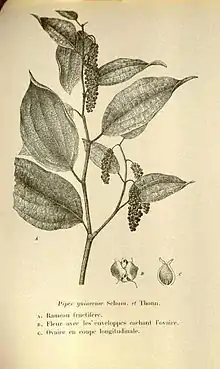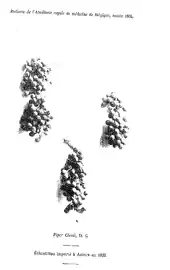Piper guineense
Piper guineense is a West African species of Piper; the spice derived from its dried fruit is known as Ashanti pepper, Benin pepper, Edo pepper, false cubeb, Guinea cubeb, and called locally kale, kukauabe, masoro, etiñkeni, sasema, soro wisa, eyendo, oziza and uziza. It is a close relative of cubeb pepper and a relative of black pepper and long pepper. Unlike cubeb, which is large and spherical in shape, Ashanti pepper grains are prolate spheroids, smaller and smoother than Cubeb pepper in appearance and generally bear a reddish tinge.[1] The stalks of Ashanti pepper berries are also distinctly curved whilst those of cubeb pepper are completely straight.[1] The terms West African pepper and Guinea pepper have also been used, but are ambiguous and may refer to grains of Selim or grains of paradise.
| Piper guineense | |
|---|---|
 | |
| Scientific classification | |
| Kingdom: | Plantae |
| Clade: | Tracheophytes |
| Clade: | Angiosperms |
| Clade: | Magnoliids |
| Order: | Piperales |
| Family: | Piperaceae |
| Genus: | Piper |
| Species: | P. guineense |
| Binomial name | |
| Piper guineense | |
| Synonyms | |
|
Piper clusii C.DC. | |
The plants that provide Ashanti pepper are vines that can grow up to 20 m in length, climbing up boles of trees by means of adventitious roots. These are native to topical regions of Central and Western Africa and are semi-cultivated in countries such as Nigeria where the leaves, known as uziza, are used as a flavouring for stews. Like other members of the pepper family, Ashanti pepper contains 5–8% of the chemical piperine which gives them their piquant taste. They contain large amounts of beta-caryophyllene, which is being investigated as an anti-inflammatory agent.[2] It also contains significant proportions (up to around 10%) of myristicin, elemicin, safrole, and dillapiol, as well as some apiole (around 1.4%).
In terms of flavour, Ashanti pepper is very similar to cubeb pepper but is less bitter and has a fresher, more herbaceous flavour and aroma than cubeb's more pine-like scent. Though known in Europe during the Middle Ages (it was a common spice in Rouen and Dieppe in 14th-century France), these days, its use is largely marginalized to West and Central Africa.
Use in cuisine

It is used in West African cuisine where it imparts spiciness and a pungent aroma to stews. Even in West Africa, Ashanti pepper is an expensive spice and is used sparingly. Often, a few grains are ground in a pestle and mortar before being added (along with black pepper) to soups or to boiled rice. The spice can also be substituted in any recipe calling for cubeb pepper, where Ashanti imparts a less bitter flavour. The pepper is also sometimes one of the ingredients in the Berbere spice mix used in the cuisines of Ethiopia and of Eritrea. However, West African Pepper is a highly esteemed spice in its region of origin and may be hard to get abroad; thus, long pepper is more often used in Berbere.
As a preservative
Research shows that Ashanti peppers have preservative and anti-oxidant properties. In a comparison study of three native West African peppers on the preservation of catfish, Ashanti peppers were discovered to be the most effective.[3]
References
- Katzer, Gernot. "Cubeb pepper (Piper cubeba, cubebs)". Gernot Katzer's Spice Pages. Retrieved 26 May 2015.
- Younis, Nancy S.; Mohamed, Maged E. (2019-05-19). "β-Caryophyllene as a Potential Protective Agent Against Myocardial Injury: The Role of Toll-Like Receptors". Molecules. 24 (10). doi:10.3390/molecules24101929. ISSN 1420-3049. PMC 6572120. PMID 31109132.
- Kiin-Kabari, D. B.; Barimalaa, I. S.; Achinewhu, S. C.; Adeniji, T. A. (2011). "Effects of extracts from three indigenous spices on the chemical stability of smoke-dried catfish (Clarias lezera) during storage". African Journal of Food, Agriculture, Nutrition and Development. 11 (6). Retrieved 11 November 2012.